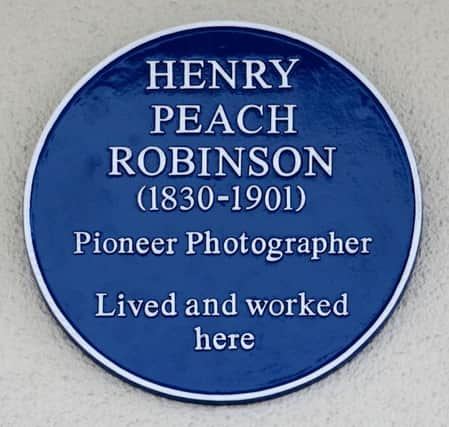Two new blue plaques put up in honour of former Leamington men


Plaques for William Amey and Henry Peach Robinson were put up at 13 Willes Road and the building currently occupied by H&M at 60-62 the Parade, respectively.
They were unveiled by town mayor Cllr Amanda Stevens and members of the Blue Plaque Committee last Wednesday.
Advertisement
Hide AdAdvertisement
Hide AdBorn in Birmingham in 1881, William Amey was the seventh of eight children of a railway carriage fitter.


Little more is known of his early life other than that he had a job as a chandelier worker employed by Verity’s Ltd electrical manufacturers.
In 1914 he joined the 1/8th Territorial Battalion of the Royal Warwickshire Regiment when it was formed in Birmingham in August 1914.
Crossing to France with the battalion in March 1915, William served mainly on the Western Front but also in Italy.
Advertisement
Hide AdAdvertisement
Hide AdHe became a corporal and is thought to have fought at the Somme and Passchendaele.
On July 22 1919, the London Gazette announced that William had been awarded the Military Medal.
He had already been awarded the Victoria Cross on November 4 1918 for “conspicuous bravery during the attack on Landrecies.”
The report said: “On his own initiative, he led his section against a machine gun nest and, under heavy fire, drove the garrison onto a neighbouring farm before capturing 50 prisoners.
Advertisement
Hide AdAdvertisement
Hide Ad“Later, single-handedly and again under heavy fire, he attacked another machine gun post, killed two of the garrison and drove the remainder into a cellar until assistance arrived.
“He displayed, throughout the day, the highest degree of valour and determination.”
After the war, William lived in Willes Road where he spent the rest of his life with the wife he had met at Landrecies in northern France.
He was a prominent member of the Royal British Legion, attending Victoria Cross events at Buckingham Palace and the House of Lords.
Advertisement
Hide AdAdvertisement
Hide AdHe died at Warneford Hospital in 1940 and was buried at Leamington Cemetery.
Henry Peach Robinson was born in Ludlow in 1830 and, showing artistic prowess in his early adulthood, had an oil painting accepted by the Royal Academy.
He came to Leamington in 1853 to work for a bookseller and publisher of The Courier.
A £100 loan from a friend - worth £7,000 today - allowed Henry to set up a studio and shop at 60-64 the Parade before he joined the Royal Photographic Society.
Advertisement
Hide AdAdvertisement
Hide AdHaving produced a book. Warwickshire Illustrated, which helped to keep him afloat, Henry worked on a technique that produced his first surviving photograph - Juliet with the Poison Bottle.
Then, in 1858, he produced the photograph which made his name - Fading Away.
This study of a young woman dying of consumption was noticed by Prince Albert, who bought a print of this and Henry’s later works.
Having wrote several books, most notably Pictorial Effect in Photography, Henry was first elected as vice-president of the Royal Photographic Society and in 1900 - the year before he died - an Honorary Fellow.